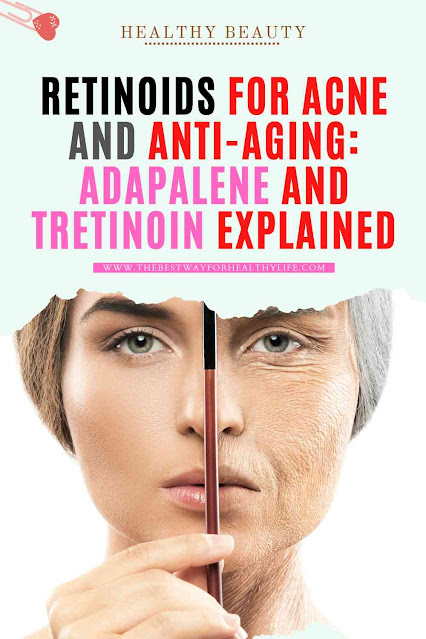Retinoids for Acne and Anti-Aging: Adapalene and Tretinoin Explained
 |
| tretinoin versus adapalene |
Retinoids for Acne and Anti-Aging: Adapalene and Tretinoin Explained
Are Tretinoin and Adapalene the same?
Adapalene and tretinoin are topical medications belonging to the retinoid family, which are vitamin A derivatives. However, they're not the same.
Tretinoin vs Adapalene
Adapalene is a second-generation retinoid, which means it is less potent and generally less irritating than tretinoin, a first-generation retinoid.
However, tretinoin is more effective in treating acne and improving the appearance of aging skin due to its higher potency.
They are commonly used to treat acne and improve the appearance of fine lines, wrinkles, and hyperpigmentation. Read more about adapalene here and tretinoin here.
Tretinoin vs Adapalene for Acne
Adapalene and tretinoin are effective acne treatments and improve the skin's appearance. Both ingredients increase cell turnover and reduce clogged pore formation, which can lead to acne breakouts.
Other options for treating acne include topical antibiotics, such as clindamycin and erythromycin, and benzoyl peroxide, a topical medication that helps kill acne-causing bacteria.
Oral medications like antibiotics and isotretinoin may also treat severe or resistant acne. In addition to topical and oral medications, several other treatment options may help manage acne.
These include chemical peels, which can help to exfoliate the skin and improve the appearance of acne scars, and light therapy, which uses specific wavelengths of light to kill acne-causing bacteria and reduce inflammation.
It is important to speak with a dermatologist to determine the best treatment plan for your acne. A combination of topical and oral medications, as well as other treatments, may be necessary to effectively getting rid of acne.
Tretinoin vs Adapalene for Anti Aging
Besides treating acne, adapalene, and tretinoin are great ingredients for aging skin. They help stimulate collagen production, improving the appearance of fine lines, wrinkles, and uneven skin tone.
As we age, our skin's natural production of collagen, a protein that helps to keep skin firm and elastic, slows down. This can lead to the development of fine lines, wrinkles, and sagging skin.
Retinoids like adapalene and tretinoin can help stimulate collagen production and increase cell turnover, improving the skin's texture and tone.
In addition to retinoids, other treatments, such as chemical peels, laser therapies, and injectables, may also be recommended to help improve the appearance of aging skin
Tretinoin or Adapalene
Ultimately, the best choice between adapalene and tretinoin will depend on an individual's specific skin concerns and the tolerability of the medication.
While both adapalene and tretinoin can effectively improve the appearance of aging skin, tretinoin may be more potent and, therefore, more effective in treating more severe signs of aging.
However, it may also be more irritating for some people. Adapalene may be a good option for people with sensitive skin or just starting to use retinoids. It is important to speak with a dermatologist to determine the best treatment plan for your skin.
Can I use Tretinoin and Adapalene together?
Many people often ask that question. The answer is Not! Both these ingredients, Tretinoin and Adapalene, work similarly, which is they exfoliate your skin.
If you use Tretinoin and Adapalene together, it will cause skin irritation. Both these medication causes the same side effects, which it can disturb your skin barrier.
Tretinoin and Adapalene Side Effects
In general, adapalene may be a good option for people with sensitive skin or who are just starting to use retinoids, as it is less irritating than tretinoin.
However, tretinoin may be more effective for people with more severe acne or those looking to improve the appearance of aging skin.
Following your dermatologist's instructions when using adapalene or tretinoin is important, as improper use can lead to irritation or other side effects.
The side effect that are often caused by retinoids such as dryness, flaking, and redness when first starting treatment.
These side effects usually go away with continued use. Using a broad-spectrum sunscreen while using retinoids is also important, as they can increase the skin's sensitivity to the sun.
How to use Tretinoin and Adapalene
These medications should be applied to the skin as directed, usually once daily at night. It is important to start with a low concentration and gradually increase the strength as tolerated.
Retinoids can dry your skin, so using them with a moisturizer is important. Please use a non-comedogenic moisturizer to help prevent dryness and flaking.
When using retinoids, please avoid using other products that can be irritating or drying, such as alpha-hydroxy acids or benzoyl peroxide.
Please also avoid waxing or using other hair removal methods on skin treated with retinoids, as they can cause irritation.
And remember to avoid prolonged sun exposure while using retinoids, as they can increase the skin's sensitivity to the sun.
It is important to use a broad-spectrum sunscreen with an SPF of at least 30 to protect the skin from sun damage.
Closing
Several other topical retinoids can also treat acne and improve the appearance of aging skin.
These include retinol, a less potent form of retinoid available over the counter, and tazarotene, another prescription-strength retinoid
Post a Comment for "Retinoids for Acne and Anti-Aging: Adapalene and Tretinoin Explained"